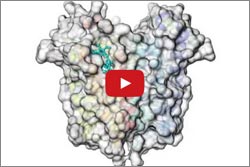What do you get when you mix a room full of scientists with a classroom full of students who have questions about cells? Cell Day 2016! During this free web chat, middle and high school students will have the opportunity to ask our scientists at NIGMS about cell biology, biochemistry, research careers and more. Join us on Thursday, November 3 anytime from 10 a.m. to 3 p.m. EDT. Registration (no longer available).
Posts by Jilliene Drayton
Structural Studies Demystify Membrane Protein
Mitochondria have proteins that span their membranes to control the flow of messages and materials moving into and out of the organelle. One way scientists can learn more about how membrane proteins function—and how medicines might interact with them—is to determine their structures. But for a variety of reasons, obtaining the structures has been notoriously difficult.
Two structural studies have now shed light on the mysterious mitochondrial membrane protein TSPO. This protein plays a key role in transporting cholesterol and drugs into the cell’s mitochondria. While here, the cholesterol is converted to steroid hormones that are essential for numerous bodily functions. Although many researchers have been studying TSPO since the 1990s, they’ve remained uncertain about its mechanisms and how it truly functions. Continue reading “Structural Studies Demystify Membrane Protein”
Zinc’s Role in Healthy Fertilization

Whether aiding in early growth and development, ensuring a healthy nervous system or guarding the body from illness, zinc plays an important role in the human body.
Husband-and-wife team, Thomas O’Halloran and Teresa Woodruff, plus other researchers at Northwestern University, evaluated the role that zinc plays in healthy fertilization. The study revealed how mouse eggs gather and release billions of zinc atoms at once in events called zinc sparks. These fluxes in zinc concentration are essential in regulating the biochemical processes that facilitate the egg-to-embryo transition.
The scientists developed a series of techniques to determine the amount and location of zinc atoms during an egg cell’s maturation and fertilization as well as in the following two hours. Special imaging methods allowed the researchers to also visualize the movement of zinc sparks in three dimensions.
Continue reading “Zinc’s Role in Healthy Fertilization”Aspirin’s Dual Action

Ever wonder how aspirin knocks out aches? Scientists have known that medicine prevents an enzyme called cyclooxygenase from producing compounds linked to pain and inflammation, but they recently made another discovery about how aspirin works.
Edward Dennis and colleagues at the University of California, San Diego School of Medicine researched aspirin’s effect on macrophages–white blood cells that play a role in the body’s immune response to injury. They found that in addition to killing cyclooxygenase, aspirin causes the enzyme to make a product called 15-HETE. During infection and inflammation, 15-HETE can get converted by another enzyme into lipoxin, a compound that terminates and reverses inflammation.
Researchers will likely use lipoxin and similar compounds to develop new anti-inflammatory drugs.
Learn more:
University of California, San Diego News Release ![]()
Dennis Lab (no longer available)
Restoring the Function of an Immune Receptor Involved in Crohn’s Disease
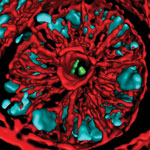
Our bodies depend on a set of immune receptors to remove harmful bacteria and control the growth of helpful bacteria in our guts. Genetic changes that alter the function of the receptors can have an adverse effect and result in chronic inflammatory diseases like Crohn’s disease. Catherine Leimkuhler Grimes and Vishnu Mohanan of the University of Delaware researched a Crohn’s-associated immune receptor, NOD2, to figure out how it can lose the ability to respond properly to bacteria. In the process, they identified the involvement of a protective protein called HSP70. Increasing HSP70 levels in kidney, colon and white blood cells appeared to restore NOD2 function. This work represents a first step toward developing drugs to treat Crohn’s disease.
This work was funded in part by an Institutional Development Award (IDeA) Network of Biomedical Research Excellence (INBRE) grant.
Two Proteins That Regulate Energy Use Play Key Role in Stem Cell Development

Hannele Ruohola-Baker and a team of researchers at the University of Washington recently discovered that two proteins responsible for regulating how cells break down glucose are also essential for stem cell development. The scientists showed that the proteins HIF1 alpha and HIF2 alpha are both required to reprogram adult human cells into pluripotent stem cells, which have the ability to mature into any cell type in the body. Taking a closer look at what each protein does on its own, the researchers found that HIF1 alpha was beneficial for reprogramming throughout the process, whereas HIF2 alpha was required at early stages but was detrimental at later stages of reprogramming. Because the two proteins also play a role in transforming normal cells into cancer cells, the findings could lead to future advances in cancer research.
Learn more:
University of Washington News Release
Ruohola-Baker Lab
Once Upon a Stem Cell Article from Inside Life Science
Learning About Cancer by Studying Stem Cells Article from Inside Life Science
Sticky Stem Cells Article from Inside Life Science
Cool Image: Tick Tock, Master Clock
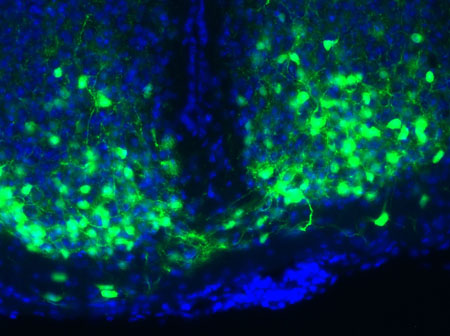
Our biological clocks play a large part in influencing our sleep patterns, hormone levels, body temperature and appetite. A small molecule called VIP, shown in green, enables time-keeping neurons in the brain’s central clock to coordinate daily rhythms. New research shows that, at least in mice, higher doses of the molecule can cause neurons to get out of synch. By desynchronizing mouse neurons with an extra burst of VIP, Erik Herzog of Washington University in St. Louis found that the cells could better adapt to abrupt changes in light (day)-dark (night) cycles. The finding could one day lead to a method to reduce jet lag recovery times and help shift workers better adjust to schedule changes.
Learn more:
Washington University in St. Louis News Release
Circadian Rhythms Fact Sheet
Tick Tock: New Clues About Biological Clocks and Health Article from Inside Life Science
A Light on Life’s Rhythms Article from Findings Magazine
Protein May Help Reduce Intestinal Injury
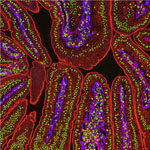
Gail Besner of Nationwide Children’s Hospital and her research team recently found out how the HB-EGF growth factor protein could potentially aid the development of treatments for a number of conditions. Using model systems in two separate studies, the scientists discovered that HB-EGF could protect the intestines from injury by stimulating cell growth and movement and by decreasing substances formed upon intestinal injury that worsen the damage. They also showed that administration of mesenchymal stem cells could further shield the intestines from injury. Future treatments involving a combination of HB-EGF and stem cells could, for example, help cancer patients sustain fewer intestinal injuries resulting from radiation therapy.
This work also was funded by NIH’s National Institute of Diabetes and Digestive and Kidney Diseases.
Learn more:
Nationwide Children’s Hospital News Release
Genes Linked to Aspirin Effectiveness
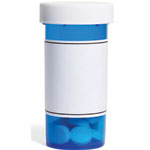
Aspirin is used often to prevent heart attacks and stroke. Yet, doctors know little about why it’s more effective in some people than others. A team of Duke University researchers, including Geoffrey Ginsburg and Deepak Voora, recently discovered a method to pinpoint the patients who benefit most from the drug as well as those who are at risk for heart attacks. By administering aspirin to a set of healthy volunteers and people with heart disease and then analyzing their gene activity patterns, the researchers identified a set of genes that correlate with insufficient platelet response to aspirin. The finding might lead to a simple blood test to help tailor treatments for heart disease.
NIH’s National Heart, Lung, and Blood Institute also supported this work.
Learn more:
Duke Medicine News Release Ginsburg Bio Voora Bio


